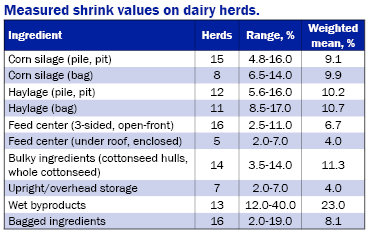
How much is feed shrink costing you?
 By Dr. Andy Kniesly
By Dr. Andy KnieslyFeed costs represent one of the largest expenses on a dairy farm. As dairy farmers look for ways to improve their profitability, they often look for ways to reduce their feed costs. One area that sometimes gets overlooked in the quest to reduce feed costs is feed shrink.
Many farmers understand there are some losses – or shrink – to the feeds they harvest and purchase. What some farmers may not know is how much feed they are losing and where all of it is going.
A common and easy way to identify shrink is to calculate the length of time a new load of feed should last based on the amount delivered, feed rate, number of animals being fed and how long it actually lasts. For example, if you feed a 24-ton load of soybean meal at a rate of 4 pounds per cow per day to 600 cows, it should last 20 days, but if you have a 5-percent shrink on that feed, it will only last 19 days. The amount of shrink varies from farm to farm, but many range from 5 to 20 percent. If feed costs are $6 per cow per day, then the value of shrink may represent a loss of $0.30 to $1.20 per cow per day. This equals $10,950 to $43,800 for every 100 cows on a yearly basis.
When it comes to shrink, the old saying is very true: You can’t monitor what you don’t measure.
To know the amount of shrink on your farm and monitor changes, you need to measure the difference between what is delivered and what is used on the farm. The use of on-farm truck scales and feed management software programs, like FeedWatch and TMR Tracker®, are tools that can help measure shrink easily.
The table below (Stone et al. 2015) shows shrink ranges from a field study on various feeds based on storage structure and type of feed.

Feed shrink can come from many different sources on the farm like weather, pests, feed spills, tracking feed on tires, scale and mixing errors, fermentation, cattle tossing feed, and refusals. Some shrink is more noticeable, like the wind blowing feed, and some shrink is less noticeable, like faulty scales on a mixer overfeeding an ingredient. Many options can be implemented to reduce feed shrink; the most successful are farm-specific.
Measuring the amount and identifying the areas of shrink on your farm can help answer the question: “Which options of reducing shrink will have the biggest return on investment?”
Take the time to look around your operation and see where your feed is other than in the cow, but remember, not all shrink is visible. Then talk to your consultants about ways to monitor and reduce shrink.
About the author: Dr. Andrew Kniesly joined Vita Plus in 2014 as a dairy specialist in Ohio. Kniesly grew up on a family farm in Dorset, Ohio and attended The Ohio State University and graduated from the OSU College of Veterinary Medicine in 2001. He then joined a veterinary practice with dairy as the primary focus. Since 2004, he has worked as a dairy nutrition consultant with a particular interest in transition cow health, milk components and cow comfort. He currently resides in Medina, Ohio with his wife and two kids and enjoys doing anything that is outdoors.
| Category: |
Dairy Performance Forage storage and management |

